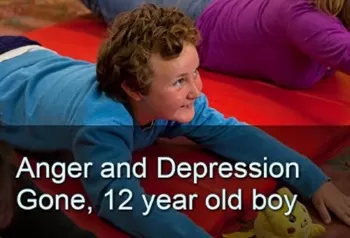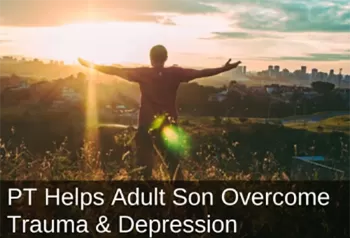Depression
Lifting Depression with Transformative Rhythmic Movements and Primitive Reflex Integration
by Sonia Story, M.S.
Human beings are meant to move with ease and strength. By moving we stay uplifted and engaged in life. A lack of movement can lead to depression. Depressed individuals are often seen with head down, slumped posture, and lethargy. One of the best ways to combat depression is through physical activity and exercise (Heissel et al., 2023). But when moving is itself tiring or uncomfortable, then beneficial exercise can be difficult to do. How can we improve our ability to move so that exercise is enjoyable and rewarding?
An inability to move well often comes from a lack of neurodevelopmental movements in the earliest stages of life. This can result in poor posture and poor quality of movement that remains through childhood and beyond. You can see a visual representation of this in the two sets of baby photos below.
 Photos: Kathleen Porter, author of Healthy Posture for Babies and Children
Photos: Kathleen Porter, author of Healthy Posture for Babies and Children
The infants in the top row are aligned with good core strength. It is infant movements that develop good posture and movement. Sadly, the infants in the bottom row lack core strength and alignment. These slumped babies are likely to struggle with fatigue and poor brain, body, and sensory development. Later in life these challenges could manifest as depression, among other issues.
Doing the neurodevelopmental movements of infancy from the Brain and Sensory Foundations program is a great way to integrate retained primitive reflexes, and to improve core strength, posture, movement quality, and mood.
A 12-year-old boy suffered with depression, anger, and sensory issues, though his mother had tried many things to help him. After doing the neurodevelopmental movements, this boy's outlook completely turned around and he became positive, productive, and less sensitive. See his uplifting story as well as additional case studies below.
The Depression-Anxiety-Early Movement Connection
Depression often goes hand-in-hand with anxiety. Both anxiety and depressive symptoms have been associated with deficits in infant and early childhood motor skills (Piek et al., 2010). Movement abilities in infancy are largely determined by engagement in the innate rhythmic and reflex movements. Better movement skills in infancy and toddlerhood correlate with a lower risk of anxiety and depression in school-age children (Piek et al., 2010). What if a child is already past the infant and toddler stages? Thankfully, innate neurodevelopmental movements can work in all stages of life to build and mature the brain, body, and sensory systems. Doing innate movements often leads to better quality of movement, integration of retained primitive reflexes, and the ability to overcome depression and anxiety no matter how old we are. Learn more about how neurodevelopmental movements help with anxiety, and see case studies on children, teens, and adults who have transformed their anxiety using the Brain and Sensory Foundations program.
Before discovering rhythmic movements and reflex integration, this boy was depressed and lethargic, had been pulled out of school due to behavior issues, and was struggling with friendships. Now, he is excited for all the possibilities in his future, is more engaged in new activities, is less clingy, and is exhibiting more mature behavior with his friends. What a difference! See his Mom's account.
This young man had challenges in almost every aspect of his life—emotional dysregulation, misophonia, panic attacks, extreme disorganization, and more. The innate rhythmic movements and reflex integration made a huge difference in helping him to function well. His mother says the changes are astonishing! Read his full story here.
This man had been diagnosed as Bipolar, and was experiencing significant anxiety, depression, and fear when separated from his wife. Tools from the Brain and Sensory Foundations course have helped ease these issues so he can now find balance in his life. Read the full case study here.
References
Heissel, A., Heinen, D., Brokmeier, L. L., Skarabis, N., Kangas, M., Vancampfort, D., Stubbs, B., Firth, J., Ward, P. B., Rosenbaum, S., Hallgren, M., & Schuch, F. (2023). Exercise as medicine for depressive symptoms? A systematic review and meta-analysis with meta-regression. British Journal of Sports Medicine, 57(16), 1049-1057.
Piek, J. P., Barrett, N. C., Smith, L. M., Rigoli, D., & Gasson, N. (2010). Do motor skills in infancy and early childhood predict anxious and depressive symptomatology at school age?. Human movement science, 29(5), 777-786.
Sonia Story, M.S. has been teaching neurodevelopmental movements since 2006.
Sonia developed the Brain and Sensory Foundations program to provide comprehensive training in neurodevelopmental movements—combining innate rhythmic movements, play, primitive reflexes, and postural reflexes.
She earned a Bachelor's degree in biology/psychology and a Master’s degree in Movement Sciences. She is the author of The Importance of Reflex Integration and the Evidence eBook, giving the rationale and evidence basis for using neurodevelopmental movements for helping with challenges such as ADHD, Sensory Processing Disorders, anxiety, emotional dysregulation, visual skill deficits, poor social skills, gross and fine motor delays and other neurodevelopmental and behavioral disorders.
Her work is featured in numerous podcasts, summits, and conferences, and in the books Almost Autism: Recovering Children from Sensory Processing Disorder; Special Ed Mom Survival Guide; Family Health Revolution; and Same Journey, Different Paths—Stories of Auditory Processing Disorder.
Sonia’s mission is to help children and families experience the profound benefits of neurodevelopmental and integrative movements for more functional and fulfilling lives.





